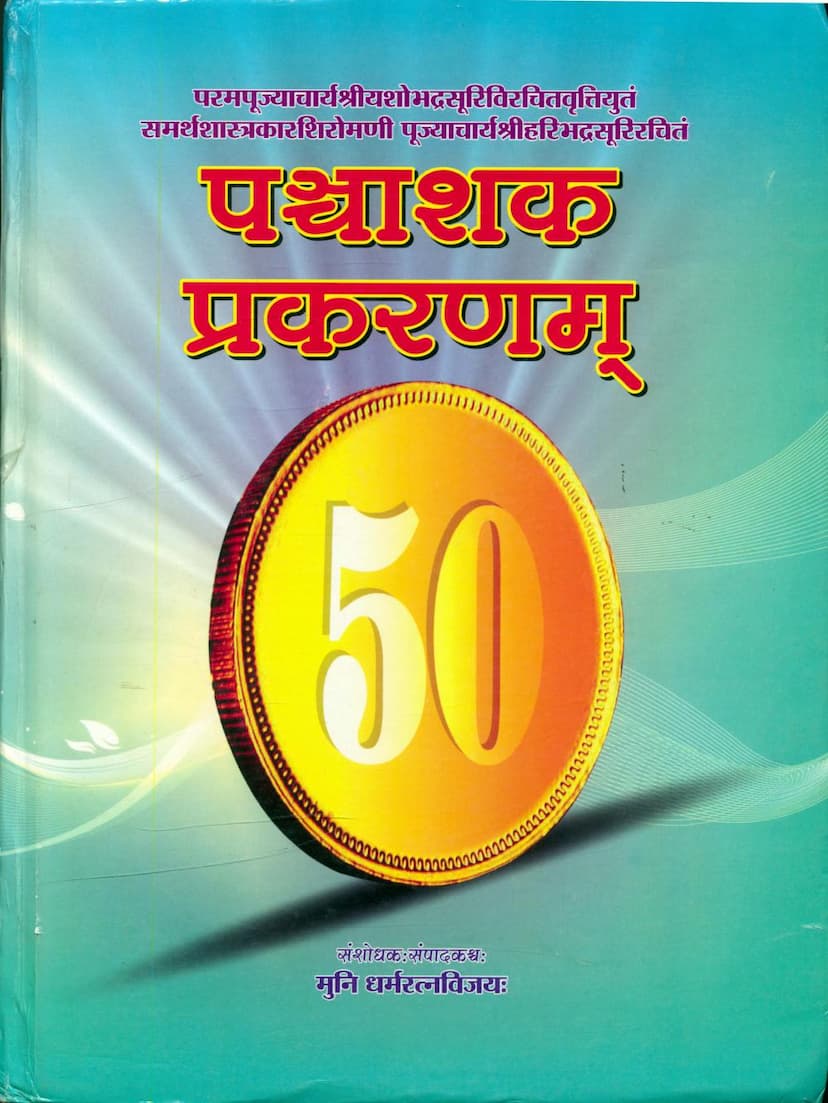Panchashak Prakaranam
Added to library: September 2, 2025

Summary
Certainly! Here's a comprehensive summary of the Jain text "Panchashak Prakaranam," authored by Dharmaratnavijay, based on the provided pages from the catalog link:
Book Title: Panchashak Prakaranam (पञ्चाशक प्रकरणम्) Author(s): Acharya Shri Haribhadra Suri (Original Work), Acharya Shri Yashobhadra Suri (Commentary) Editor/Researcher: Muni Dharmaratnavijay Publisher: Manav Kalyan Sansthanam Catalog Link: https://jainqq.org/explore/022282/1
Overall Summary:
The "Panchashak Prakaranam" is a significant Jain text attributed to the renowned Jain scholar Acharya Shri Haribhadra Suri. It is a compilation of verses, generally organized into sets of fifty (hence "Panchashak"), covering various aspects of Jain conduct and rituals for both ascetics (monks) and householders (lay followers). The text, originally composed in Prakrit, is presented here with a commentary (Vritti) by Acharya Shri Yashobhadra Suri. The present edition has been meticulously researched and edited by Muni Dharmaratnavijay, making this ancient wisdom accessible to contemporary readers.
The "Panchashak Prakaranam" is structured into twenty sections (Panchashak), each delving into specific domains of Jain practice. The book aims to elucidate the principles and practices of Jainism in a clear and comprehensive manner, drawing from core Jain scriptures (Agamas).
Key Themes and Contents:
The "Panchashak Prakaranam" covers a wide array of topics essential for spiritual and ethical living according to Jain principles. These can be broadly categorized into:
-
Lay Follower (Shravak) Dharma:
- Daily Conduct: This section likely details the daily routines, ethical observances, and spiritual practices expected of a Jain householder.
- Vows (Vratas): Explanations of the vows undertaken by lay followers, including the five main vows (Anuvaratas) and the supporting vows (Gunavratas and Shikshavratas).
- Repentance and Purification: Discussions on practices related to acknowledging and rectifying wrongdoings, likely covering aspects of confession and penance.
- Worship and Devotion: Details on performing worship (Puja) and devotional practices, including prayers and rituals.
- Pilgrimages (Yatra): Guidance on undertaking pilgrimages to sacred Jain sites.
- Iconography and Temple Rituals: Likely covers the placement and worship of Jina images and the rituals associated with Jinalayas (temples).
- Ascetic Practices for Laypersons (Upasak Pratima): The text describes twelve specific stages or vows (Pratimas) that lay followers can undertake to progressively deepen their spiritual practice, moving closer to an ascetic life.
-
Ascetic (Sadhu) Dharma:
- Renunciation and Initiation: The text likely outlines the process and significance of initiation into monastic life (Diksha).
- Monastic Conduct (Samachari): Detailed rules and guidelines for the daily life of monks, covering aspects like speech, movement, food intake, and interactions. This is a crucial and extensive part of the text.
- Purity of Alms (Pindashuddhi): Emphasis on the strict rules regarding the purity of alms (food) collected by monks, detailing the various defects and how to avoid them.
- Austerities (Tapas): Explanations of different types of austerities and their spiritual significance in shedding karma.
- Monastic Observances (Kalpa): The text distinguishes between various monastic rules and observances, possibly categorized as "sthita" (permanent) and "asthita" (temporary) kalpas, reflecting rules that are always in effect versus those that are situational or for specific periods.
- Ceremonial Purity: Rules regarding purity in various actions and substances.
Commentary and Editorial Work:
The publication highlights the critical role of the commentary by Acharya Shri Yashobhadra Suri, which is considered highly valuable for understanding the original work. The discovery and utilization of a palm-leaf manuscript from the Jinbhadra Suri Tāḍpatrīya Granth Bhandar in Jaisalmer for this commentary is a significant aspect of the editorial effort. Muni Dharmaratnavijay's extensive research and meticulous editing, involving cross-referencing with other manuscripts and scholarly insights, are credited for producing this comprehensive edition. The inclusion of various appendices, such as indexes of verses and prose passages, further enhances the scholarly value of the publication.
Significance:
The "Panchashak Prakaranam" serves as a practical guide for Jains, offering detailed instructions on how to live a life aligned with Jain principles. It bridges the theoretical teachings of Jainism with the practical application of these principles in daily life for both householders and ascetics. The commentary by Yashobhadra Suri and the editorial work of Dharmaratnavijay make this text a valuable resource for scholars and practitioners alike, contributing to the preservation and dissemination of Jain knowledge. The text emphasizes the interconnectedness of conduct, purity, and spiritual progress towards liberation (Moksha).
This summary consolidates the information presented across the provided pages, highlighting the key elements of the "Panchashak Prakaranam" and its importance within Jain literature.